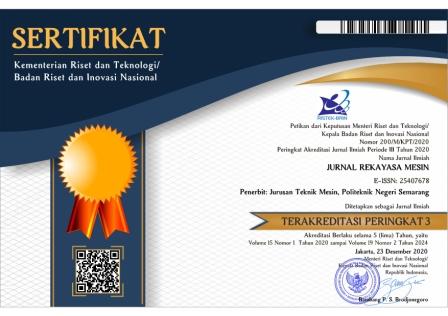Penurunan Sifat Mekanis Terpal PE Akibat Paparan Lingkungan dan Beban Kontinu
DOI:
https://doi.org/10.32497/jrm.v19i1.5198Keywords:
anyaman, komposit, polyethylene, terpalAbstract
Aplikasi terpal PE (polyethylene) sering melibatkan interaksi langsung dengan lingkungan luar dan beban. Hal ini dapat mengakibatkan perubahan pada sifat-sifatnya sehingga mempengaruhi umur pemakaian. Sejauh ini, penurunan sifat-sifat mekanis material polyethylene telah diamati pada berbagai penelitian, namun belum ada yang secara khusus berfokus pada struktur anyaman seperti terpal. Artikel ini menginvestigasi penurunan sifat mekanis yang disebabkan oleh kedua faktor di atas pada bahan terpal. Uji tarik dan uji jebol dilakukan terhadap spesimen bahan terpal yang telah dipapar cuaca selama 1, 2, dan 3 bulan, dengan dan tanpa beban kontinu. Ditemukan penurunan sifat-sifat mekanis secara bertahap seiring dengan lama paparan. Perbandingan antara spesimen terpal baru dan yang telah diberi perlakuan paparan selama 3 bulan menunjukkan penurunan kekuatan tarik dan kemuluran sebesar 56% dan 67%. Pada semua variasi waktu paparan, spesimen dengan beban kontinu mengalami penurunan sifat yang lebih besar daripada spesimen tanpa beban. Baik degradasi bahan polyethylene maupun perubahan struktur anyaman disinyalir berpengaruh terhadap perubahan karakteristik mekanis pada spesimen dengan beban kontinu.References
Bauer R, Saunde G. Panduan tentang Spesifikasi dan Penggunaan Terpal Plastik dalam Bantuan Kemanusiaan dalam Bahasa Indonesia. UK: Oxfam; 2007.
High Density Polyethylene Tarpaulins - Multiple End Use sectors n.d. http://atozplastics.com/upload/literature/High-density-Polyethylene-HDPE-Tarpaulins.asp (accessed November 27, 2023).
Ronca S. Polyethylene. Brydson”™s Plastics Materials: Eighth Edition 2017:247”“78. https://doi.org/10.1016/B978-0-323-35824-8.00010-4.
Aljoumaa K, Abboudi M. Physical ageing of polyethylene terephthalate under natural sunlight: correlation study between crystallinity and mechanical properties. Appl Phys A Mater Sci Process 2016;122:1”“10. https://doi.org/10.1007/S00339-015-9518-0/METRICS.
Gong Y, Wang SH, Zhang ZY, Yang XL, Yang ZG, Yang HG. Degradation of sunlight exposure on the high-density polyethylene (HDPE) pipes for transportation of natural gases. Polym Degrad Stab 2021;194:109752. https://doi.org/10.1016/J.POLYMDEGRADSTAB.2021.109752.
Bhuyar P, Tamizi NABM, Rahim MHAb, Maniam GP, Govindan N. Effect of ultraviolet light on the degradation of Low-Density and High-Density Polyethylene characterized by the weight loss and FTIR. Maejo International Journal of Energy and Environmental Communication 2019;1:26”“31. https://doi.org/10.54279/MIJEEC.V1I2.244915.
Rodriguez AK, Mansoor B, Ayoub G, Colin X, Benzerga AA. Effect of UV-aging on the mechanical and fracture behavior of low density polyethylene. Polym Degrad Stab 2020;180:109185. https://doi.org/10.1016/J.POLYMDEGRADSTAB.2020.109185.
Andrady AL, Lavender Law K, Donohue J, Koongolla B. Accelerated degradation of low-density polyethylene in air and in sea water. Science of The Total Environment 2022;811:151368. https://doi.org/10.1016/J.SCITOTENV.2021.151368.
Lestari P, Trihadiningrum Y, Warmadewanthi I. Simulated degradation of low-density polyethylene and polypropylene due to ultraviolet radiation and water velocity in the aquatic environment. J Environ Chem Eng 2022;10:107553. https://doi.org/10.1016/J.JECE.2022.107553.
Dan D, Cheng W, Sun L, Guo Y. Fatigue durability study of high density polyethylene stay cable sheathing. Constr Build Mater 2016;111:474”“81. https://doi.org/10.1016/J.CONBUILDMAT.2016.02.109.
Lu X, Qian R, Brown N. Discontinuous crack growth in polyethylene under a constant load. J Mater Sci 1991;26:917”“24. https://doi.org/10.1007/BF00576768/METRICS.
Plummer CJG, Goldberg A, Ghanem A. Micromechanisms of slow crack growth in polyethylene under constant tensile loading. Polymer (Guildf) 2001;42:9551”“64. https://doi.org/10.1016/S0032-3861(01)00476-1.
Daniel PL, Ioan SD, Liviu M. Studies on tensile and tear fracture of the S8210 tarpaulin. Vibroengineering Procedia 2022;46:80”“5. https://doi.org/10.21595/VP.2022.22952.
Wilson J. Woven structures and their characteristics. Woven Textiles: Principles, Technologies and Applications 2012:163”“204. https://doi.org/10.1533/9780857095589.2.163.
Astakhov VP. Mechanical Properties of Engineering Materials: Relevance in Design and Manufacturing 2018:3”“41. https://doi.org/10.1007/978-3-319-78488-5_1.
LDPE Versus HDPE n.d. https://www.vem-tooling.com/ldpe-vs-hdpe/ (accessed November 20, 2023).
Klash A, Shebani A, Elhabishi R, Abdsalam S, Elbreki H, Elhrari W. The Influence of LDPE Content on the Mechanical Properties of HDPE/LDPE Blends 2018. https://doi.org/10.31031/RDMS.2018.07.000672.
Kim YJJHJN. UV Stability of LDPE Films for Tarpaulin. Textile Science and Engineering 2017;54:164”“70. https://doi.org/10.12772/TSE.2017.54.164.
Ramadan Abd El Hamid Mohammed El-Tantawi. A. A Review on: The ratio between applied stresses and resultant strain behavior of textile materials (yarn and woven fabric). 2020.
Downloads
Published
How to Cite
Issue
Section
License
Copyright of articles that appear in Jurnal Rekayasa Mesin belongs exclusively to Penerbit Jurusan Teknik Mesin Politeknik Negeri Semarang. This copyright covers the rights to reproduce the article, including reprints, electronic reproductions, or any other reproductions of similar nature.







